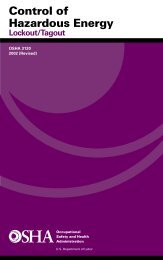Toxic Chemical Release Inventory Reporting Forms and Instructions
Toxic Chemical Release Inventory Reporting Forms and Instructions
Toxic Chemical Release Inventory Reporting Forms and Instructions
You also want an ePaper? Increase the reach of your titles
YUMPU automatically turns print PDFs into web optimized ePapers that Google loves.
<strong>Instructions</strong> for Completing Part II of EPA Form R<br />
report a RCRA ID for that waste. You should indicate NA<br />
in the RCRA ID field. Enter the complete address of the<br />
non-U.S. facility in the off-site address fields, the city in the<br />
city field, the non-U.S. state or province in the county field,<br />
the postal code in the zip code field, <strong>and</strong> the foreign country<br />
code in the country field. The most commonly used FIPs<br />
codes are listed in Table IV. To obtain a FIPS code for a<br />
country not listed, contact the EPCRA Call Center. There is<br />
nothing to enter in the state field.<br />
6.2a Column A: Total Transfers<br />
For each off-site location, enter the total amount, in pounds<br />
(in grams for dioxin <strong>and</strong> dioxin-like compounds), of the<br />
EPCRA section 313 chemical that is contained in the waste<br />
transferred to that location. Do not enter the total<br />
poundage of the waste. If you do not ship or transfer wastes<br />
containing the EPCRA section 313 chemical to other off-site<br />
locations, you should enter NA (See discussion of NA vs. a<br />
Numeric Value (e.g., Zero) in the introduction of Section 6)<br />
in the box for the off-site location’s EPA Identification<br />
Number (defined in 40 CFR 260.10 <strong>and</strong> therefore commonly<br />
referred to as the RCRA ID Number). If the total amount<br />
transferred is less than 1,000 pounds, you may report a range<br />
by entering the appropriate range code (range reporting in<br />
section 6.2 does not apply to PBT chemicals). The following<br />
reporting range codes are to be used:<br />
Code<br />
<strong>Reporting</strong> Range (in pounds)<br />
A 1–10<br />
B 11–499<br />
C 500–999<br />
Unloading<br />
Method Vessel Type Value<br />
Pumping Steel drum Range<br />
Mean<br />
Pumping Plastic drum Range<br />
Mean<br />
Pouring<br />
Pouring<br />
Gravity<br />
Drain<br />
Gravity<br />
Drain<br />
Gravity<br />
Drain<br />
Bung-top steel<br />
drum<br />
Open-top steel<br />
drum<br />
Slope-bottom<br />
steel tank<br />
Dish-bottom<br />
steel tank<br />
Summary of Residue Quantities From Pilot-Scale Experimental Study a,b<br />
(weight percent of drum capacity)<br />
Material<br />
Dish-bottom<br />
glass-lined tank<br />
Range<br />
Mean<br />
Range<br />
Mean<br />
Range<br />
Mean<br />
Range<br />
Mean<br />
Range<br />
Mean<br />
Kerosene c Water d Motor Oil e Solution f<br />
Surfactant<br />
1.93 – 3.08<br />
2.48<br />
1.69 – 4.08<br />
2.61<br />
0.244 – 0.472<br />
0.404<br />
0.032 – 0.080<br />
0.054<br />
0.020 – 0.039<br />
0.033<br />
0.031 – 0.042<br />
0.038<br />
0.024 – 0.049<br />
0.040<br />
1.84 – 2.61<br />
2.29<br />
2.54 – 4.67<br />
3.28<br />
0.266 – 0.458<br />
0.403<br />
0.026 – 0.039<br />
0.034<br />
0.016 – 0.024<br />
0.019<br />
0.033 – 0.034<br />
0.034<br />
0.020 – 0.040<br />
0.033<br />
1.97 – 2.23<br />
2.06<br />
1.70 – 3.48<br />
2.30<br />
0.677 – 0.787<br />
0.737<br />
0.328 – 0.368<br />
0.350<br />
0.100 – 0.121<br />
0.111<br />
0.133 – 0.191<br />
0.161<br />
0.112 – 0.134<br />
0.127<br />
3.06<br />
3.06<br />
Not<br />
Available<br />
0.485<br />
0.485<br />
0.089<br />
0.089<br />
0.048<br />
0.048<br />
0.058<br />
0.058<br />
0.040<br />
0.040<br />
a<br />
From “<strong>Release</strong>s During Cleaning of Equipment.” Prepared by PEI Associates, Inc., for the U.S. Environmental Protection Agency, Office of<br />
Pesticides <strong>and</strong> <strong>Toxic</strong> Substances, Washington DC, Contract No. 68-02-4248. June 30, 1986.<br />
b The values listed in this table should only be applied to similar vessel types, unloading methods, <strong>and</strong> bulk fluid materials. At viscosities greater<br />
than 200 centipoise, the residue quantities can rise dramatically <strong>and</strong> the information on this table is not applicable.<br />
c<br />
For kerosene, viscosity = 5 centipoise, surface tension = 29.3 dynes/cm 2<br />
d<br />
For water, viscosity = 4 centipoise, surface tension = 77.3 dynes/cm 2<br />
e<br />
For motor oil, viscosity = 94 centipoise, surface tension = 34.5 dynes/cm 2<br />
f<br />
For surfactant solution, viscosity = 3 centipoise, surface tension = 31.4 dynes/cm 2<br />
48 <strong>Toxic</strong>s <strong>Release</strong> <strong>Inventory</strong> <strong>Reporting</strong> <strong>Forms</strong> <strong>and</strong> <strong>Instructions</strong>
















